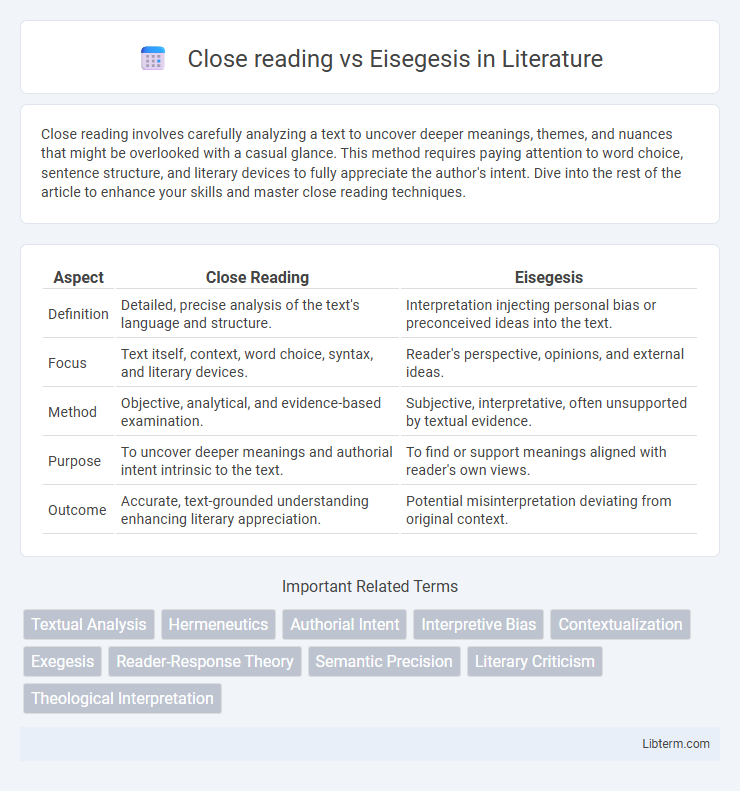Close reading involves carefully analyzing a text to uncover deeper meanings, themes, and nuances that might be overlooked with a casual glance. This method requires paying attention to word choice, sentence structure, and literary devices to fully appreciate the author's intent. Dive into the rest of the article to enhance your skills and master close reading techniques.
Table of Comparison
| Aspect | Close Reading | Eisegesis |
|---|---|---|
| Definition | Detailed, precise analysis of the text's language and structure. | Interpretation injecting personal bias or preconceived ideas into the text. |
| Focus | Text itself, context, word choice, syntax, and literary devices. | Reader's perspective, opinions, and external ideas. |
| Method | Objective, analytical, and evidence-based examination. | Subjective, interpretative, often unsupported by textual evidence. |
| Purpose | To uncover deeper meanings and authorial intent intrinsic to the text. | To find or support meanings aligned with reader's own views. |
| Outcome | Accurate, text-grounded understanding enhancing literary appreciation. | Potential misinterpretation deviating from original context. |
Understanding Close Reading: Definition and Principles
Close reading is a detailed, analytical approach to interpreting a text, emphasizing the author's language, structure, and meaning without imposing external ideas. It involves careful examination of word choice, syntax, and literary devices to uncover multiple layers of meaning inherent to the text itself. This method contrasts with eisegesis, which injects personal biases or interpretations, making close reading essential for objective and precise textual analysis.
Defining Eisegesis: What It Means and Its Implications
Eisegesis involves interpreting a text by injecting one's own presuppositions, biases, or personal perspectives rather than extracting meaning inherent in the text itself. This approach contrasts with close reading, which emphasizes careful, objective analysis of the text's language, structure, and context to uncover authorial intent and original meaning. Relying on eisegesis can lead to distorted understanding and misrepresentation of the text's message, impacting scholarly work, religious interpretation, and literary criticism.
Historical Origins of Close Reading and Eisegesis
Close reading originated in the early 20th century with the New Criticism movement, emphasizing detailed textual analysis to uncover layers of meaning within the text itself. Eisegesis, contrastingly, traces its roots to ancient interpretive traditions where readers project their own biases or assumptions onto the text, often prioritizing personal or contemporary viewpoints over the original context. The historical divergence highlights close reading's focus on textual integrity versus eisegesis's tendency toward subjective interpretation.
Key Differences Between Close Reading and Eisegesis
Close reading emphasizes analyzing the text itself, focusing on its language, structure, and meaning without external bias, whereas eisegesis involves interpreting the text by injecting one's own ideas or biases. Close reading prioritizes objective understanding grounded in the author's intent, while eisegesis often leads to subjective interpretations detached from the original context. Key differences include close reading's reliance on textual evidence and eisegesis's tendency to distort meaning by imposing personal agendas.
The Role of Textual Evidence in Close Reading
Close reading emphasizes the careful analysis of textual evidence, prioritizing the exact words, structure, and literary devices used by the author to uncover deeper meanings within the text. This method relies on interpreting the text itself without external biases or personal interpretations, contrasting with eisegesis, which imposes the reader's own ideas onto the text. Effective close reading involves detailed examination of quotations and context to support interpretations grounded strictly in the text's content.
Subjectivity and Personal Bias in Eisegesis
Eisegesis involves interpreting a text through the lens of personal bias and subjective viewpoints, often leading to distorted or imposed meanings that reflect the reader's own beliefs rather than the original intent. This subjective approach contrasts sharply with close reading, which emphasizes careful, objective analysis of the text's language, structure, and context to uncover meaning inherent within the text itself. Recognizing the impact of personal bias in eisegesis is crucial for maintaining intellectual rigor and fidelity in textual interpretation.
Practical Applications: Examples of Close Reading
Close reading enhances literary analysis by encouraging detailed examination of language, structure, and meaning, enabling readers to interpret texts based on evidence within the text itself. Practical applications include analyzing character development in Shakespeare's *Hamlet*, exploring the intricacies of metaphors in Emily Dickinson's poetry, and investigating narrative techniques in James Joyce's *Ulysses*. This method helps uncover nuanced themes and authorial intent, promoting critical thinking and deeper engagement with the text.
Pitfalls and Consequences of Eisegesis
Eisegesis involves interpreting a text by imposing one's own biases or assumptions, leading to distorted meanings and inaccurate conclusions. This pitfall undermines the integrity of the original message, resulting in misinterpretations that can mislead readers or scholars. Close reading, by contrast, emphasizes careful, objective analysis of the text itself, preserving the author's intended meaning and promoting more reliable understanding.
Choosing the Right Approach: Academic and Interpretive Contexts
Close reading emphasizes detailed analysis of the text itself, prioritizing context, language, and structure to uncover intended meanings. Eisegesis involves interpreting a text by embedding one's personal biases or assumptions, often diverging from the original context. In academic settings, close reading is preferred for rigorous, objective analysis, while eisegesis may appear in personal or theological interpretations where subjective insights are applied.
Integrating Close Reading and Eisegesis in Literary Analysis
Integrating close reading and eisegesis in literary analysis enhances interpretive depth by balancing textual evidence with critical insight. Close reading emphasizes detailed examination of language, structure, and meaning within the text, ensuring fidelity to the author's intentions and context. Eisegesis allows for the incorporation of external knowledge and personal perspectives, fostering a dynamic dialogue between the text and the reader's interpretive framework.
Close reading Infographic

 libterm.com
libterm.com